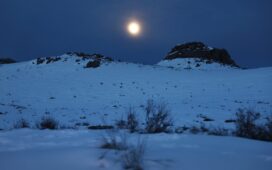1/21
Ed White photographed by Gemini 4 Commander Jim McDivitt. During the first of 66 orbits, they made an unsuccessful attempt to rendezvous with the spent upper stage of their Titan launch vehicle. On McDivitt’s advice, White waited one more orbit to recover from the effort of the failed rendezvous, and then exited the Gemini for his historic spacewalk on June 3, 1965.
Courtesy of NASA
2/21
Apollo 9 CM pilot Dave Scott emerges from the hatch, testing some of the spacesuit systems that will be used for lunar operations. The photo was taken from the hatch of the docked LM by Rusty Schweickart in March 1969.
Courtesy of NASA
3/21
Mothership “Balls Three” overflies an X-15 in 1961. Three operational X-15s were constructed and
flown for 199 test flights between them, as they pushed at the “envelopes” of speed and altitude, and reached the very edges of space.
Courtesy of NASA
4/21
The Mercury Control Center (MCC) at Cape Canaveral supervised seven human spaceflights between May 1961 and March 1965, into the beginning of the Gemini era. Meanwhile the more advanced control complex in Houston was taking shape ahead of Apollo.
Courtesy of NASA
5/21
Robert McCall’s mid-1970s prediction of NASA’s space shuttle building a modular space station is close to what finally happened, except that the real shuttles only flew one at a time.
Courtesy of NASA
6/21
Technicians working at the base of Alan Shepard’s Mercury-Redstone 3 launch vehicle are swathed in vapour from vented excess oxidiser gas on May 5, 1961. Subsequent rockets could not be so closely approached when fueling.
Courtesy of NASA
7/21
The Rendezvous Docking Simulator at Langley prepared Gemini astronauts for the strange physics of orbital flight.
Courtesy of NASA
8/21
Ahead of Gemini 10, Commander John Young explains to the media how copilot Michael Collins will inspect the Agena Target Docking Vehicle during his spacewalk, 1966.
Courtesy of NASA
9/21
Navy divers prepare to retrieve the Gemini 6A crew on December 16, 1965. Green dye was released by spacecraft on splashdown, making it easier to spot from the air.
Courtesy of NASA
10/21
The U.S. geological Survey’s map of the area around Tycho Crater, famous as the site of a mysterious alien monolith in the 1968 science fiction film “2001: A Space Odyssey.” In real life, this chaotic and rugged terrain would have been too difficult for an Apollo mission to access.
Courtesy of NASA
11/21
Apollo 11 Command Module Pilot Michael Collins inspects NASA’s Lunar Receiving Laboratory at the Manned Spacecraft Center in Houston, where rock samples collected by Apollo were analysed. Nitrogen gas protected the rocks from accidental corrosion in Earth’s oxygen-rich atmosphere.
Courtesy of NASA
12/21
NASA scientists are confident that Buzz Aldrin’s boot prints from Apollo 11 are still as sharp and distinct today as when they were first stamped down in 1969, because the Moon has no air or rain to erode them.
Courtesy of NASA
13/21
NASA’s Anechoic Chambers are among the quietest places anywhere on earth. Walls absorb almost all stray echoes, whether sound or radio. This 1972 model of a shuttle, being tested for radio characteristics, has thruster pods on the wingtips.
Courtesy of NASA
14/21
Lightning strikes the launchpad of Space Shuttle Challenger on August 30, 1983 prior to STS-8, the first pre-dawn launch of the space shuttle program. Launchpads are surrounded by tall lightning towers and other conductive systems.These create a giant “Faraday Cage,” diverting the electric charge of strike well away from the spacecraft.
Courtesy of NASA
15/21
The ISS has been continuously occupied since November 2000. Its habitable volume is equivalent to a Boeing 747’s. An international crew of six people live and work while traveling at five miles (8 km) per second, orbiting Earth once every 90 minutes. This is the single most complex and ambitious engineering effort in history, even when compared to Apollo.
Courtesy of NASA
16/21
The Hypersonic Inflatable Aerodynamic Decelerator (HIAD) is a hybrid of parachute and balloon technology. A new generation of flexible heat shield materials could enable a huge shield to be deployed from a small storage canister just before a spaceraft hits the atmosphere of its target planet. In July 2012 a HIAD survived a trip through Earth’s atmosphere at 7,600 mph.
Courtesy of NASA
17/21
In April 2016, ocean scientists at NASA’s Goddard Space Flight Center in Maryland, analysing data from Landsat 8, found mysterious lines crisscrossing the vegetation in the shallow waters of the North Caspian Sea.The cause turned out to be ice gouging at the seafloor in winter, before melting in the spring, and leaving just these clues.
Courtesy of NASA
18/21
Curiosity made this self-portrait on August 5, 2015, by maneuvering the Mars Hand Lens Imager (MAHLI) camera on the end of a seven-foot-long robotic arm. Multiple overlapping frames were acquired, then digitally stitched together by image analysts at JPL. The arm moved into a new position for each frame but the camera always pointed toward a specific
“vanishing point” to minimize parallax distortions.
Courtesy of NASA
19/21
Jupiter’s moon Io is dwarfed by the planet it orbits, as seen by the Cassini spacecraft en route to Saturn. Cassini’s 13-year tour of the ringed planet changed the course of planetary exploration.
Courtesy of NASA
20/21
A technician prepares to unlatch a small door built into the guide vanes of the Transonic Wind Tunnel at Langley Research Center in 2010. The vanes prevent turbulent eddies from interfering with the tests.
Courtesy of NASA
21/21
Courtesy of NASA
1/21
Ed White photographed by Gemini 4 Commander Jim McDivitt. During the first of 66 orbits, they made an unsuccessful attempt to rendezvous with the spent upper stage of their Titan launch vehicle. On McDivitt’s advice, White waited one more orbit to recover from the effort of the failed rendezvous, and then exited the Gemini for his historic spacewalk on June 3, 1965.
Courtesy of NASA
2/21
Apollo 9 CM pilot Dave Scott emerges from the hatch, testing some of the spacesuit systems that will be used for lunar operations. The photo was taken from the hatch of the docked LM by Rusty Schweickart in March 1969.
Courtesy of NASA
3/21
Mothership “Balls Three” overflies an X-15 in 1961. Three operational X-15s were constructed and
flown for 199 test flights between them, as they pushed at the “envelopes” of speed and altitude, and reached the very edges of space.
Courtesy of NASA
4/21
The Mercury Control Center (MCC) at Cape Canaveral supervised seven human spaceflights between May 1961 and March 1965, into the beginning of the Gemini era. Meanwhile the more advanced control complex in Houston was taking shape ahead of Apollo.
Courtesy of NASA
5/21
Robert McCall’s mid-1970s prediction of NASA’s space shuttle building a modular space station is close to what finally happened, except that the real shuttles only flew one at a time.
Courtesy of NASA
6/21
Technicians working at the base of Alan Shepard’s Mercury-Redstone 3 launch vehicle are swathed in vapour from vented excess oxidiser gas on May 5, 1961. Subsequent rockets could not be so closely approached when fueling.
Courtesy of NASA
7/21
The Rendezvous Docking Simulator at Langley prepared Gemini astronauts for the strange physics of orbital flight.
Courtesy of NASA
8/21
Ahead of Gemini 10, Commander John Young explains to the media how copilot Michael Collins will inspect the Agena Target Docking Vehicle during his spacewalk, 1966.
Courtesy of NASA
9/21
Navy divers prepare to retrieve the Gemini 6A crew on December 16, 1965. Green dye was released by spacecraft on splashdown, making it easier to spot from the air.
Courtesy of NASA
10/21
The U.S. geological Survey’s map of the area around Tycho Crater, famous as the site of a mysterious alien monolith in the 1968 science fiction film “2001: A Space Odyssey.” In real life, this chaotic and rugged terrain would have been too difficult for an Apollo mission to access.
Courtesy of NASA
11/21
Apollo 11 Command Module Pilot Michael Collins inspects NASA’s Lunar Receiving Laboratory at the Manned Spacecraft Center in Houston, where rock samples collected by Apollo were analysed. Nitrogen gas protected the rocks from accidental corrosion in Earth’s oxygen-rich atmosphere.
Courtesy of NASA
12/21
NASA scientists are confident that Buzz Aldrin’s boot prints from Apollo 11 are still as sharp and distinct today as when they were first stamped down in 1969, because the Moon has no air or rain to erode them.
Courtesy of NASA
13/21
NASA’s Anechoic Chambers are among the quietest places anywhere on earth. Walls absorb almost all stray echoes, whether sound or radio. This 1972 model of a shuttle, being tested for radio characteristics, has thruster pods on the wingtips.
Courtesy of NASA
14/21
Lightning strikes the launchpad of Space Shuttle Challenger on August 30, 1983 prior to STS-8, the first pre-dawn launch of the space shuttle program. Launchpads are surrounded by tall lightning towers and other conductive systems.These create a giant “Faraday Cage,” diverting the electric charge of strike well away from the spacecraft.
Courtesy of NASA
15/21
The ISS has been continuously occupied since November 2000. Its habitable volume is equivalent to a Boeing 747’s. An international crew of six people live and work while traveling at five miles (8 km) per second, orbiting Earth once every 90 minutes. This is the single most complex and ambitious engineering effort in history, even when compared to Apollo.
Courtesy of NASA
16/21
The Hypersonic Inflatable Aerodynamic Decelerator (HIAD) is a hybrid of parachute and balloon technology. A new generation of flexible heat shield materials could enable a huge shield to be deployed from a small storage canister just before a spaceraft hits the atmosphere of its target planet. In July 2012 a HIAD survived a trip through Earth’s atmosphere at 7,600 mph.
Courtesy of NASA
17/21
In April 2016, ocean scientists at NASA’s Goddard Space Flight Center in Maryland, analysing data from Landsat 8, found mysterious lines crisscrossing the vegetation in the shallow waters of the North Caspian Sea.The cause turned out to be ice gouging at the seafloor in winter, before melting in the spring, and leaving just these clues.
Courtesy of NASA
18/21
Curiosity made this self-portrait on August 5, 2015, by maneuvering the Mars Hand Lens Imager (MAHLI) camera on the end of a seven-foot-long robotic arm. Multiple overlapping frames were acquired, then digitally stitched together by image analysts at JPL. The arm moved into a new position for each frame but the camera always pointed toward a specific
“vanishing point” to minimize parallax distortions.
Courtesy of NASA
19/21
Jupiter’s moon Io is dwarfed by the planet it orbits, as seen by the Cassini spacecraft en route to Saturn. Cassini’s 13-year tour of the ringed planet changed the course of planetary exploration.
Courtesy of NASA
20/21
A technician prepares to unlatch a small door built into the guide vanes of the Transonic Wind Tunnel at Langley Research Center in 2010. The vanes prevent turbulent eddies from interfering with the tests.
Courtesy of NASA
21/21
Courtesy of NASA
A self-portrait of the mars rover, pictures of footprints on the moon and satellite images of the most remote places in our solar system have all been taken from Nasa’s archives to commemorate the 60th birthday of the world’s most famous space agency.
The collection contains over 400 pictures that show Nasa’s achievements in space travel as well as the humans that have driven them.
Accompanying the photos is text charting Nasa’s past, present and future from the book’s editor, Piers Bizony, and Nasa historians.
Join Independent Minds
For exclusive articles, events and an advertising-free read for just
£5.99
€6.99
$9.99
a month
Get the best of The Independent
With an Independent Minds subscription for just
£5.99
€6.99
$9.99
a month
The Nasa archives is available now from Taschen.
Subscribe to Independent Minds to bookmark this article
Want to bookmark your favourite articles and stories to read or reference later? Try Independent Minds free for 14 days to access this feature.













